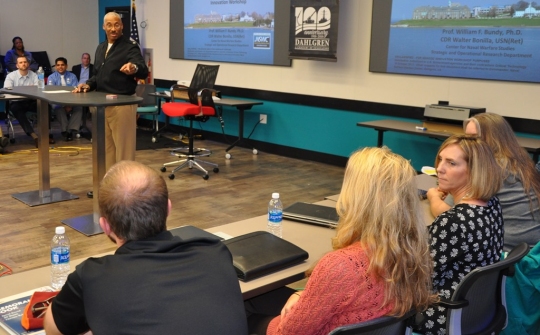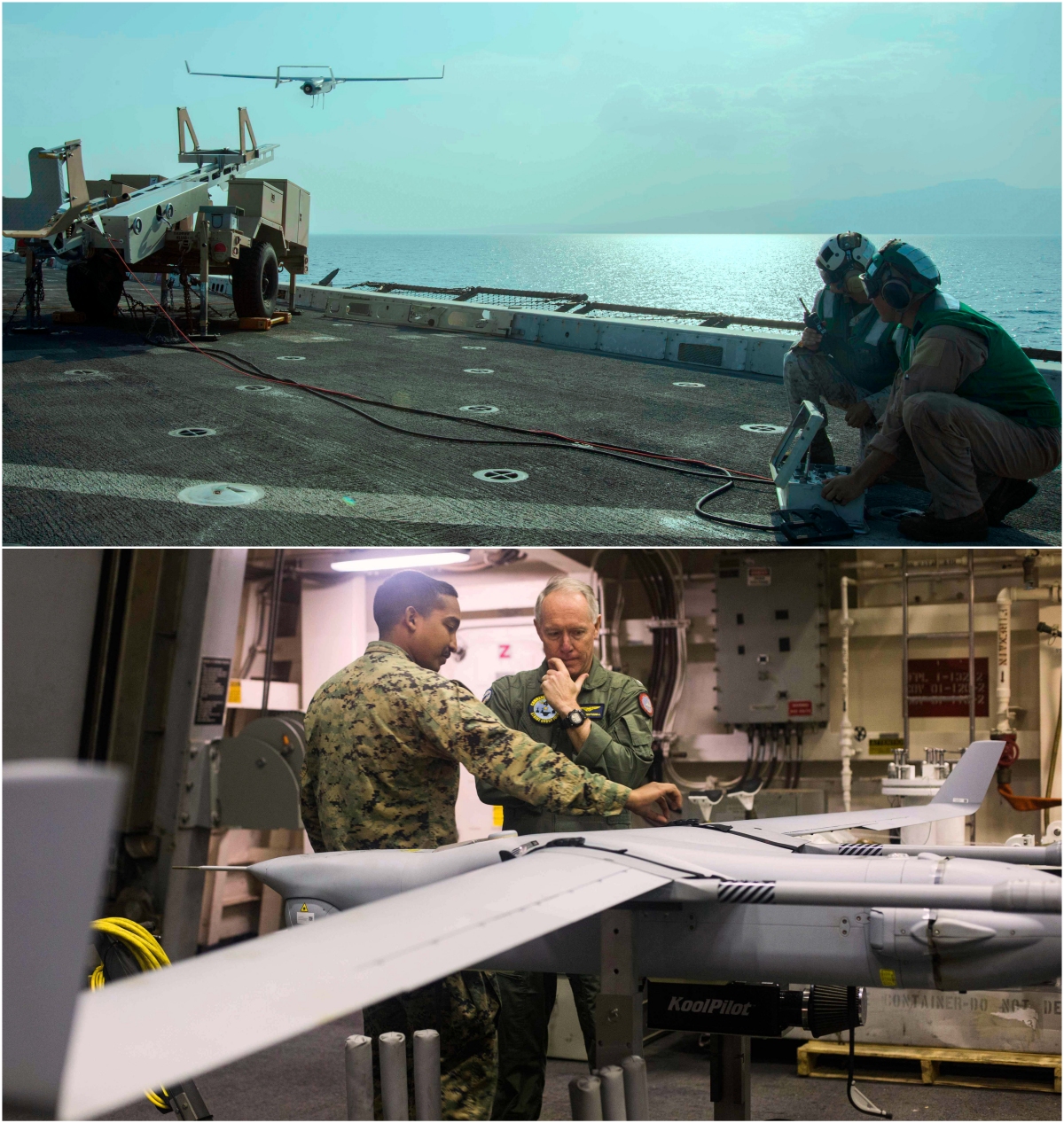 DAHLGREN, Va. - Rear Adm. Jesse Wilson, Naval Surface Force Atlantic commander, emphasizes the importance of innovating to the strategic environment as he spoke to a group of civilian technologists and military officers at the first in a series of Surface Warfare Innovation Workshops held at the Navy's newest Innovation Lab. Naval Surface Warfare Center Dahlgren Division (NSWCDD) and the Navy War College co-sponsored the event that encouraged NSWCDD scientists and engineers to throw away the rule book as they brainstormed to solve future warfighting scenarios. "The workshop enabled Navy leadership to share current and future Fleet concerns with our new and mid-career personnel to develop united, focused, and creative solutions," said NSWCDD I-Lab Director of Innovation Nelson Mills. (U.S. Navy photo/Released)
DAHLGREN, Va. - Rear Adm. Jesse Wilson, Naval Surface Force Atlantic commander, emphasizes the importance of innovating to the strategic environment as he spoke to a group of civilian technologists and military officers at the first in a series of Surface Warfare Innovation Workshops held at the Navy's newest Innovation Lab. Naval Surface Warfare Center Dahlgren Division (NSWCDD) and the Navy War College co-sponsored the event that encouraged NSWCDD scientists and engineers to throw away the rule book as they brainstormed to solve future warfighting scenarios. "The workshop enabled Navy leadership to share current and future Fleet concerns with our new and mid-career personnel to develop united, focused, and creative solutions," said NSWCDD I-Lab Director of Innovation Nelson Mills. (U.S. Navy photo/Released)DAHLGREN, Va. (Nov. 21, 2017)—A new Innovation Lab is revolutionizing the Navy's thinking and collaboration about its future Fleet with events like the Surface Warfare Innovation Workshop, Naval Surface Warfare Center Dahlgren Division (NSWCDD) announced Nov. 20.
As scientists and engineers explore transformational ideas in the Innovation Lab, or I-Lab—NSWCDD officials anticipate a surge of technological advances, approaches, and capabilities to further empower the nation's warfighters to fight, win, and return home safely.
"The I-Lab is engaging our workforce and helping to retain talent through challenging collaborations, critical thinking opportunities, and rewarding problem solving for the warfighter," said NSWCDD Technical Director John Fiore. "It is my belief the pursuit of these types of labs will unleash the entrepreneurial spirit of our scientists and engineers to ultimately benefit our customers—Sailors and Marines keeping our nation secure and hoping to come home to their loved ones safe."
The NSWCDD I-Lab—equipped with state-of-the-art equipment, services, and trained personnel—opened for business over the summer as an intensive collaborative environment where NSWCDD experts work to speed up and maximize corporate innovative solutions across the laboratory.
"I am very excited about our new I-Lab that stimulates, promotes, and merges ideas into concepts for analysis, prototyping, experimentation, and transition as needed—but this is only the beginning," said Fiore. "We have plans to expand our free play environments to include workshops that will allow us to free play with a variety of technologies, machine tools, and 3D printers."
Innovators are using gear that includes mobile networked touch screens with collaboration 'Bluescape' workspace capability, a 3D printer, Surface Pro computers, a multi-touch collaboration table, self-contained holographic glasses, mobile glass boards, and unclassified video teleconference capability.
The I-Lab is reconfigurable to support large innovative workshops as well as smaller, more focused events, including classified and unclassified break-out rooms. For example, NSWCDD and the Naval War College co-sponsored the command's first Surface Warfare Innovation Workshop, Oct. 17-19.
"The workshop was focused on gaining a foundation for current and future warfighting concepts and requirements," said Fiore. "Presentations and panel talks provided the opportunity for our technologists, engineers, and scientists to learn from OPNAV (Chief of Naval Operations staff) strategic planners, OPNAV surface warfare specialists, and visionaries."
I-Lab Innovators Envision Robotics and Quantum Computing in Future Fleet
Future world models of military-political environments, Navy missions, and warfighting requirements were featured to stimulate possible technology and functional solutions.
"Solutions ranged from continued employment of current functional capabilities to the use of autonomy, robotics, quantum computing, and other advances in science that can be installed in Navy ships and assets," said Nelson Mills, I-Lab's director of innovation.
On the event's first day, flag officers and senior government officials spoke with 60 NSWCDD experts about surface, air, and undersea warfare.
"We gained incredible insights from over 20 senior leaders on a variety of surface warfare topics, challenges, and issues," said Mills. "Team members were exposed to a new brainstorming thought process. They expanded personal networks, met and worked with incredibly talented people, and further developed their ability to innovate while engaging with guest speakers and panels."
Four panel sessions were conducted on surface force strategy, warfighter perspectives, unmanned systems integration, future fleet structure, digital warfare advances, emerging capability requirements, future technologies, and possible warfighting futures. Panel members conveyed their experience, concerns, issues, knowledge, and vision for the future of surface warfare.
What's more, the panel discussed Navy themes related to interoperability, mission planning, enhanced weapons, and an abundance of inexpensive deployed unmanned systems in the Fleet.
Innovators Throw Away the Rule Book to Solve Future Warfighting Scenarios
At one point, Naval War College professor Dr. Bundy encouraged workshop participants to "throw away the rule book," "think out of the box," "think without a box," "imagine," and perhaps most of all "have fun" throughout the workshop.
"The workshop enabled Navy leadership to share current and future Fleet concerns with our new and mid-career personnel to develop united, focused, and creative solutions," said Mills. "Our innovators were invigorated through motivational speakers as we identified, addressed, and overcame impediments along the way."
The participants—mostly civilian scientists and engineers as well as a few active duty military officers—responded by brainstorming about technology that enables functional capabilities, including sensors, networks, command and control, weapons, distributed lethality, and battle management concepts.
They broke up into groups that tackled a myriad of naval warfighting scenarios generated by the Naval War College for the 2020, 2025, and 2030 timeframes. On the final day, the break-out groups presented their culminating concepts to Rear Adm. Jesse Wilson, Naval Surface Force Atlantic commander.
Wilson emphasized the importance of innovating to the strategic environment and getting new technologies into the hands of Sailors quickly. The next 25 years in the maritime security environment is going to be very different than the last quarter of a century, he told the participants, adding that it's essential to prepare for changes and challenges while innovating to ensure the Navy is ready today and tomorrow.
In all, four teams of NSWCDD scientists and engineers worked with specific scenarios, approaches, and solutions by employing the IDEO (innovation, design, engineering, and organization) process while brainstorming to achieve innovative answers, potential prototypes, and integrated kill chain capabilities. A 'kill chain' refers to the process of identifying and thwarting threats, typically from reconnaissance, until the threat is eliminated. It also applies to threats in cyberspace and to the electromagnetic spectrum—identifying and eliminating intrusions in the networks.
The teams' four scenarios were:
• Credible Combat Power in the Sea Frontier: Protection of the U.S. East Coast, West Coast, and Gulf of Mexico in 2020.
• Securing the Maritime Commons: Anti-piracy mission off the Horn of Africa in 2025.
• Maritime Strategic Deterrence: Ballistic Missile Defense type mission with 40 percent of the U.S. Navy being unmanned in 2025.
• Capstone: Maritime Battle Force: At war in 2030.
Themes comprising autonomy, automation, artificial intelligence, and machine learning were addressed by the teams.
At the conclusion of each scenario—as part of the innovative IDEO framework for the workshop—the teams described their innovative solutions acquired via brainstorming, introduced possibilities along with prototype ideas, and presented a realistic capability solution using a system integration or kill chain approach.
Technologies for the Future Fleet, USS Zumwalt, Autonomy, and Unmanned Ships
NSWCDD is planning future Surface Warfare Innovation Workshops to be held at dates to be determined. The events will explore technology and systems development opportunities for the Navy's future Surface Combatant Fleet, potential new capabilities impacting the Navy's most technologically advanced surface combatant—USS Zumwalt (DDG 1000), and autonomy enabled by artificial intelligence and machine learning via unmanned surface ships.
A workshop focusing on the Navy's future surface combatant would assess functional capabilities and alternative sensors, weapons, and control systems envisioned for the future surface combatant Fleet.
"NSWCDD innovators can learn what is initially planned for the Fleet and offer advances in sensors, control-networks, weapons-effectors, and other technologies," said Mills. "Sponsors for a Future Surface Combatant Workshop would include recently hired NSWCDD engineers and technologists, mid-term engineers and innovators, and OPNAV N96 invited surface warfare officers. The outcome of this workshop would provide assessments of planned and alternative payloads, sensors, and systems; create innovative solutions; and offer Fleet-perspective learning for NSWCDD staff."
A USS Zumwalt capabilities workshop—in cooperation with the Navy's Surface Warfare Directorate and the Commander of U.S. Pacific Fleet—would explore innovative capabilities for Zumwalt Class guided-missile destroyers. It would assess employment roles for Zumwalt Class guided-missile destroyers and explore technologies that will enable role missions, integration, and interoperability with the Fleet.
"Participants should include Fleet planners, Zumwalt Class guided-missile destroyer officers, OPNAV Surface Warfare Directorate personnel, Naval Operations for Information Warfare personnel, OPNAV Future Fleet Design and Architecture staff, NSWC engineers, and other participants who can contribute to the workshop goals," said Mills.
A workshop featuring autonomy enabled by artificial intelligence and machine learning via unmanned surface ships could be held in cooperation with the Deputy Assistant Secretary of the Navy for Unmanned Systems in conjunction with the Navy's surface and undersea warfare centers.
"It would explore near, mid, and far-term unmanned system integration opportunities for unmanned surface ships," said Mills. "These integration opportunities include the range of surface force employment of unmanned surface vehicles and ships. In fact, we identified one functional capability during the inaugural workshop that deserves further assessment and possible technical solutions."



